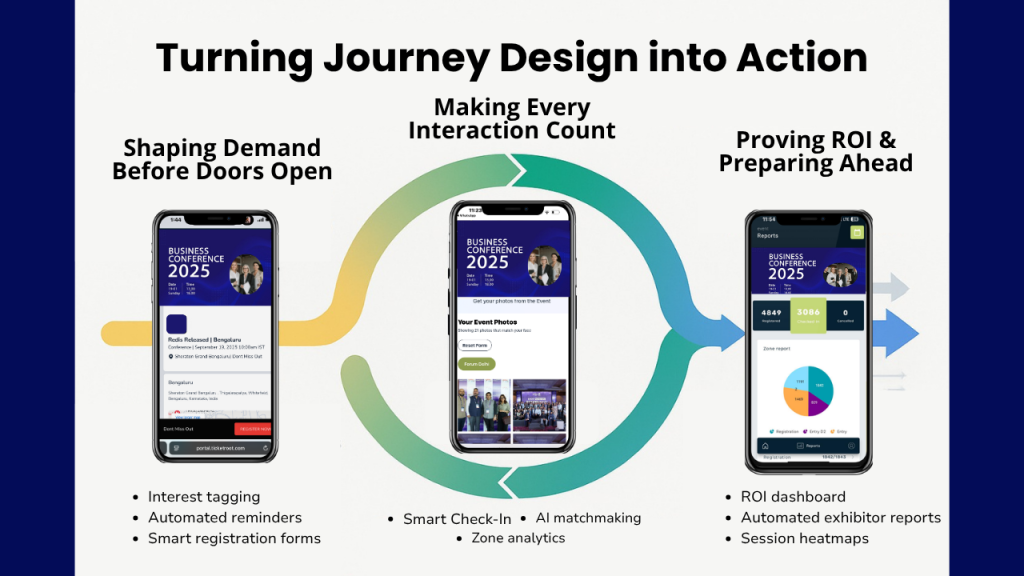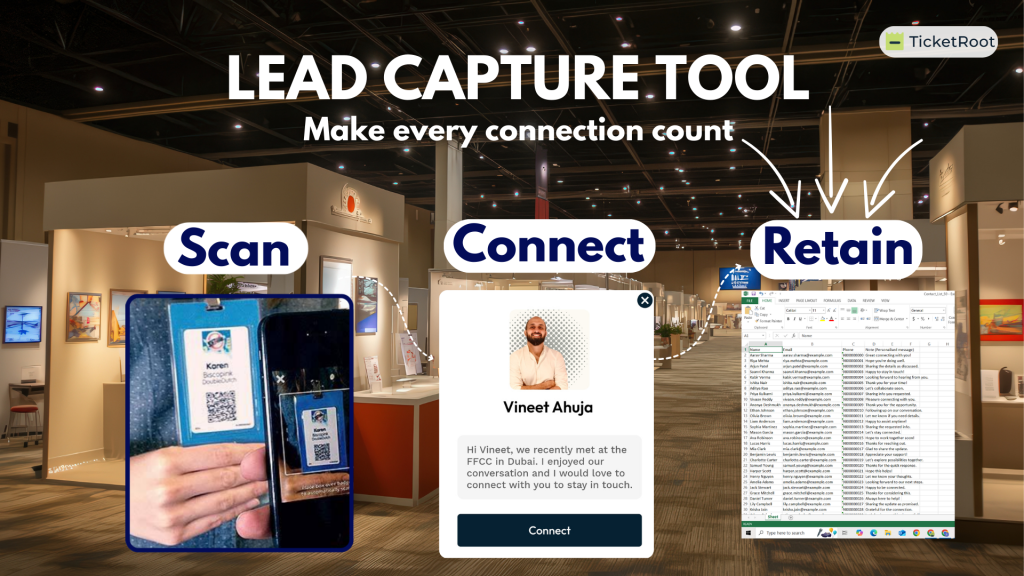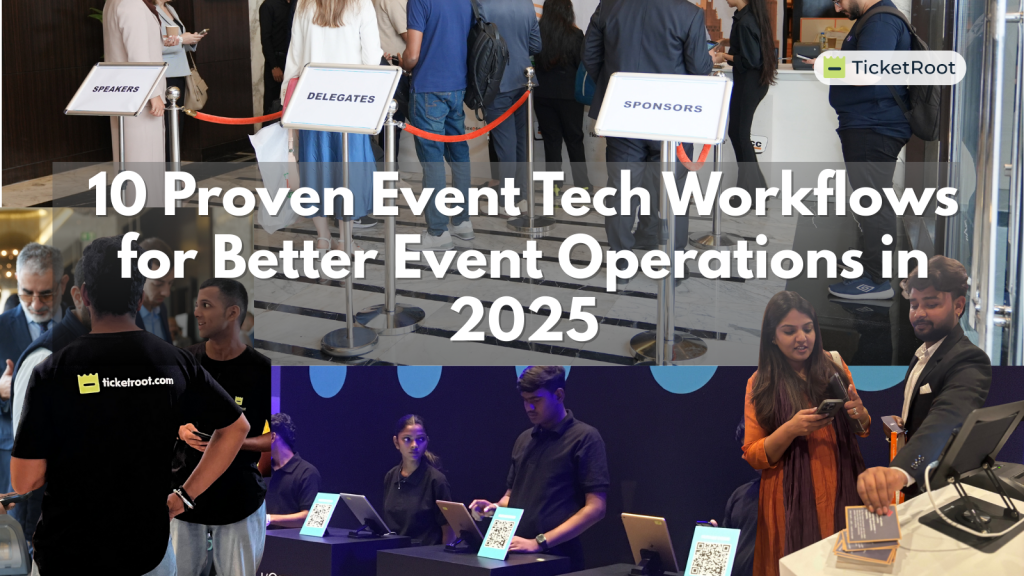How Designing the Attendee Journey Boosts Exhibitor ROI: A Guide for Event Organizers
Most event organizers still treat the attendee journey as separate moments: registration happens, then check-in, then booth visits, then follow-ups. Exhibitors don’t think this way. They care about one thing: conversations that convert.
When every step of an attendee’s experience routes them toward meaningful exhibitor conversations, the metrics change. Pre-booked meetings happen. Lead quality improves. ROI becomes measurable. Call it journey design or just smart planning either way, you’re engineering outcomes, not hoping for them.
The Journey That Works
Your best events? The ones where attendees actually found the right booth, had a meaningful conversation, and exhibitors saw results? That wasn’t random, it was designed.
Here’s what a connected journey looks like:
Before the event, attendees build profiles with their interests and goals. They explore exhibitors, bookmark sessions, and sometimes pre-book meetings. By the time they walk through the door, they’ve already decided who they want to see.
On-site, check-in is instant. Their preferences guide them to relevant sessions. When they visit a booth, context is there. Staff capture actual details: what was discussed, photos, next steps.
After the event, exhibitors get reports showing which conversations mattered. Attendees get nurtured by the right sponsors. Organizers know exactly which booth placements worked and why.
The thread connecting all of this: every interaction creates context for the next one. You’re not starting from scratch at each stage.

Stage 1: Pre-Event Discovery Sets the Tone
An attendee’s journey begins weeks before doors open. Most organizers miss this.
When you give attendees a space to explore, a public event hub, sponsor spotlights, session previews, they start self-selecting into conversations. They bookmark sessions. They flag exhibitors they want to meet. They pre-book meetings.
This matters because exhibitors can plan too. They know who’s coming. They can brief their team. Instead of hoping for foot traffic, they’re ready for the conversations they actually care about.
Making this work means keeping it simple. Interest tags. Straightforward questions: “What are you looking for?” Reminders through email, SMS, or WhatsApp (where enabled) keep attendees informed and engaged. Session recommendations based on role or industry work everywhere.
When done right, a meaningful share of attendees pre-book meetings before the event starts.
With CRM and registration data synced early, organizers can forecast engagement and help exhibitors prepare outreach before the event begins.
Stage 2: Smart Connections Replace Chance
Random badge scans at booths are the old way. An exhibitor hopes the right person walks by. Most visitors aren’t qualified. Most conversations go nowhere.
Smart networking flips this. AI matchmaking pulls from the data attendees already provided like their role, interests, goals. It surfaces the right people to each other. An attendee sees “Meet the right people” cards in the app. An exhibitor gets pre-matched introductions.
The trade-off matters: pre-booked meetings reduce overall booth footfall, but they increase lead quality dramatically. A B2B event with 500 highly-qualified conversations beats one with 5,000 random scans. A consumer festival might want the opposite. Know what your sponsors actually value, and design accordingly.
For smaller exhibitors worried about being overlooked, manual overrides help. Featured exhibitor lists. Strategic booth placement. Don’t let the algorithm do all the work.
Stage 3: Capture Context, Not Just Contacts

Most lead capture is broken. A checkbox. A business card scan. Data that never reaches sales. By Friday, it’s forgotten.
Lead capture that actually sticks works differently. Exhibitor staff scan a badge, jot down a quick note about the conversation, and the lead syncs instantly or exports to CRM in real time.
The barrier isn’t technology, it’s adoption. If exhibitors have to fill out ten fields, they won’t do it. Keep it simple: photo + note. Scalable tools work for 50-person events and 50,000-person expos alike.
Stage 4: Integration Doesn’t Mean Starting Over
Many organizers are cautious about integrations, and for good reason. The upside is, your existing tools don’t need to be replaced.
TicketRoot connects to what you’re already using, registration platforms, CRMs, badge printers through existing APIs or middleware, so your current setup stays intact and data moves cleanly between systems.
The rollout is straightforward. First event: connect check-in and badging. Second event: layer in pre-event discovery. Third event: add lead capture. You prove each piece works before expanding.
Stage 5: Make Trade-offs Deliberately
Every feature adds value, but it also has a cost, in attendee attention, staff time, or on-site friction. The best organizers don’t pile on tools. They make deliberate trade-offs based on what their exhibitors actually value.
- Pre-booked meetings drive efficiency but reduce spontaneous floor energy.
- Live agenda nudges keep traffic balanced but can overwhelm if unfiltered.
- AI matchmaking raises lead quality but risks bias toward major exhibitors.
The best event designs engineer the right density of interaction in the right places. High-intent meetings in the exhibition hall. Balanced traffic across sessions. Sponsors reaching their actual target accounts.
Stage 6: Reporting That Helps You Plan Better
ROI doesn’t live in a dashboard, it lives in what the data explains. Numbers only matter if they show which parts of the experience actually moved the conversation forward.
When the event’s data ecosystem is connected, booth interactions, dwell time, and session engagement automatically map back to exhibitor lead records. This gives organizers a clear view of which areas drove results and where experience design can be improved for the next edition.
Effective ROI reporting turns engagement data into direction. It highlights where value was created and where attention should shift for the next edition.
Building a Journey That Connects
A connected attendee experience makes one-on-one interactions something you can leverage. Pre-event discovery directs on-site engagement; on-site engagement inspires post-event reporting; and exhibitor feedback informs the design of future events.
Event planners who concentrate on bridging these phases don’t use more tools they use more alignment. Eventually, that process creates smarter events, stronger exhibitor connections, and measurable value across the journey. Here’s a simple reference you can use to check whether the key pieces are in place:
Before the event
→ Let attendees build profiles with interests and goals
→ Make exhibitor listings visible early through bookmarks or pre-bookings help
→ Use simple questions to guide discovery (“What are you looking for?”)
→ Share reminders via WhatsApp, SMS, or email
→ Give exhibitors visibility into who’s coming and why
On-site
→ Ensure check-in is quick and reliable (QR or badge-based)
→ Highlight featured booths and sessions clearly
→ Keep lead capture tools light: scan + short note
→ Support smaller exhibitors with visibility or placement where needed
→ Make it easy for staff to report what’s working in real time
After the event
→ Deliver clean lead reports with context, not just contact info
→ Share personalized content with attendees based on what they engaged with
→ Log booth visits, session scans, dwell time for future planning
→ Gather exhibitor and sponsor feedback before the momentum fades
→ Use this cycle to inform layout, tools, and content for your next event
Getting it right doesn’t mean building more. It means making each piece inform the next, so the experience feels connected, and the outcomes are actually useful.






